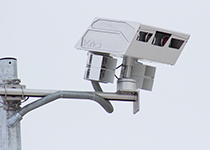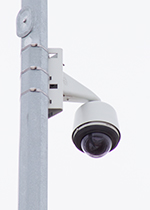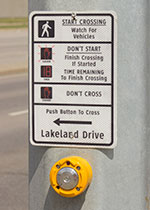Strathcona County relies on state-of-the-art technology to keep traffic moving smoothly. Traffic engineers and technologists operate and monitor traffic flows using specialized traffic analysis software, advance traffic management systems, video detection equipment, and traffic control devices.
Although traffic signals may seem simple, in reality, their management and operation are very complex. Small changes in one part of the transportation network impacts other areas; therefore, decisions made in traffic signal operation must consider all road users.
There are approximately 88 traffic signals that Strathcona County owns and operates.

Left-turn lane changes

At several County intersections, you will notice that dual left-turn lanes have been changed to single lanes. Drivers turning left at these intersections will now be able to do so for the duration of a green light, instead of during a green arrow light only.
As seen in the photo above, when two vehicles are turning at the same time, sightlines can be restricted. Consequently, collisions in dual left-turn lanes are more frequent and severe than in single turn lanes.
In Strathcona County, there are several intersections that have less traffic volume and do not warrant double left-turn bays at this time.
By changing these intersections to single-lane only left turns with protected permissive signals (green arrow and green ball lights), we can defer the need to install protected only (green arrow only) left turn signals in order to maintain the efficiency of traffic flow and reduce wait times. These intersections will be monitored to ensure results are as expected.
The County will continue to upgrade the left turn signals to “protected only” for remaining locations with dual left-turn lanes.
Left-turn lane changes
-
Why are dual lanes being changed to single lanes at certain intersections?
1. Why are dual lanes being changed to single lanes at certain intersections?
Permanent link to Why are dual lanes being changed to single lanes at certain intersections?Over the past decade, Alberta municipalities have started to monitor dual left-turn lane operations because of the increase in frequency and severity of crashes.
When two vehicles are turning at the same time, sightlines can be restricted. Consequently, collisions in dual left-turn lanes are more frequent and severe than in single turn lanes.
To prevent unsafe turns, national engineering standards for dual lanes at signalized intersections require left turns on green arrow lights only. While these turns are safer, Strathcona County residents feel they are restrictive and reduce efficiency.
As certain intersections have less traffic volume and do not warrant double left-turn bays at this time, the County can change to single-lane left turns, and allow drivers to go through an entire green light instead of during a green arrow light only.
This is expected to improve traffic flow and reduce wait times.
-
Why did we build dual lanes in the first place?
2. Why did we build dual lanes in the first place?
Permanent link to Why did we build dual lanes in the first place?Strathcona County has been strategically adding double left-turn lanes at various intersections during road rehabilitation projects for the past two decades to accommodate future left-turn demand.
When traffic volumes warrant the dual left-turn bays (more than 10 years, or as growth and traffic increases require), we can open up the second lane and make these turns green arrow only.
-
Are other municipalities in Alberta making similar changes?
3. Are other municipalities in Alberta making similar changes?
Permanent link to Are other municipalities in Alberta making similar changes?As traffic volumes have increased in Alberta, Alberta Transportation and Alberta municipalities—including Edmonton and Calgary—now follow these standards and implement protected-only left-turn signals with dual left-turn lanes.
In Strathcona County, we have dual left-turn lanes with green arrow only left-turn signals, where traffic volume warrants.
However, residents have been calling for change to improve traffic flow. We’ve therefore implemented single left-turn lanes at intersections with less traffic volume, where drivers can then turn left on both green arrow and green ball left-turn signals.
-
Intersections that have reduced to single left-turn lanes are:
- Lakeland Drive and Clover Bar Road northbound
- Lakeland Drive and Clover Bar Road eastbound
- Lakeland Drive and Sherwood Drive northbound
- Lakeland Drive and Broadmoor Boulevard northbound
- Lakeland Drive and Broadmoor Boulevard southbound
- Lakeland Village Boulevard and Clover Bar Road eastbound
- Lakeland Village Boulevard and Clover Bar Road northbound
- Baseline Road and Shivam Road southbound
- Wye Road and Ash Street southbound
- Wye Road and Ash Street westbound
- Summerwood Boulevard and Clover Bar Road westbound
-
In the winter, how will I know if a turning lane is single or double?
5. In the winter, how will I know if a turning lane is single or double?
Permanent link to In the winter, how will I know if a turning lane is single or double?New signage will be installed and existing pavement markings will be changed to ensure that drivers are aware of the change.
Signal coordination and timing
-
How do you decide where traffic signals should be installed?
1. How do you decide where traffic signals should be installed?
Permanent link to How do you decide where traffic signals should be installed?As intersection traffic and pedestrian volumes increase, it may be necessary to install a traffic signal. Before installing a traffic signal, several criteria are evaluated such as traffic volumes, proximity to schools or facilities, collision history and the positive and negative effects that will result.
Advantages of traffic signals:
- Establishing right-of-way of vehicles and pedestrians
- Reducing right-angle collisions
- Providing adequate time for vehicles and pedestrians to cross the intersection
Disadvantages of traffic signals:
- Can increase overall intersection delay
- Can divert traffic to other residential streets
- Can attract additional traffic to the intersection
- Can Increase rear-end collisions
-
Traffic signals in Sherwood Park are mostly coordinated for the main corridors with the goal of moving the greatest number of vehicles through the system with the fewest stops. In signal coordination, the busiest traffic movements are given precedence over the lesser traffic movements.
We design signal timings to prioritize and balance the needs of all road users, including pedestrians. We aim to review and update signal timings every three years to ensure all traffic signals are coordinated and adequate green times are provided.
-
Why does it seem like some traffic signals are not coordinated at all?
3. Why does it seem like some traffic signals are not coordinated at all?
Permanent link to Why does it seem like some traffic signals are not coordinated at all?Traffic signals may not seem to be coordinated in some driving directions because it is not easy or possible to provide perfect signal coordination for traffic movements in all directions. The signal coordination is adjusted at various time periods of the day to accommodate changing traffic patterns.
When the traffic flow is heavier in one direction, such as heading west on Baseline Road in the morning rush times, the signals are coordinated to favour the highest volume of vehicles. However, coordination for one direction of travel may result in more stops and delays for the other direction with fewer vehicles. Thus, when traffic volumes are relatively balanced, the traffic signals are timed so that the “reds” and “greens” are balanced in both directions. As a result, residents who express concerns about signal timings are often travelling midday or against the higher volumes of vehicles.
-
Do traffic signals operate on the same timing all day?
4. Do traffic signals operate on the same timing all day?
Permanent link to Do traffic signals operate on the same timing all day?Signal timing parameters are adjusted at various periods of the day to accommodate changing traffic patterns. To respond to varying traffic volume levels, many intersections change their operational parameters at least five times per day.
In general, most traffic signals have four basic timing plans:
- AM Peak Plan: Monday to Friday, 6 a.m. to 9 a.m.
- PM Peak Plan: Monday to Friday, 3 p.m. to 7 p.m.
- Night Plan: Monday to Sunday, 11 p.m. to 6 a.m.
- Off-Peak Plan: Remainder of time
Some traffic signals also have additional timing plans to accommodate special traffic conditions, such as school drop-off and pick-up hours, community special events, construction detour plans, etc.
-
Why do signal lights no longer flash between 11 p.m. and 6 a.m.?
5. Why do signal lights no longer flash between 11 p.m. and 6 a.m.?
Permanent link to Why do signal lights no longer flash between 11 p.m. and 6 a.m.?The flash mode was removed for several reasons:
- When signals are in flash, pedestrian crossing lights don’t operate, leaving pedestrians to cross the road at their own discretion and care. Drivers may not be able to see crossing pedestrians at night, especially if the pedestrians do not have bright or reflective clothing. The lack of signal control and visibility of pedestrians creates a safety concern.
- As traffic volume drops after 11 p.m., it is most effective to operate traffic signals in free (non-coordinated) mode, where traffic signals will operate at the minimum cycle lengths. During free operation, traffic signals on the main corridors in Sherwood Park (Baseline Road, Wye Road, Sherwood Drive, Clover Bar Road and Broadmoor Boulevard) will remain green until there is a side-street demand by either a pedestrian or vehicle.
- Strathcona County was the only remaining jurisdiction in the Capital Region to use programmed flash during the night. This may have confused visiting drivers.
Signal length
-
Why did I have to wait over two minutes at a traffic light?
1. Why did I have to wait over two minutes at a traffic light?
Permanent link to Why did I have to wait over two minutes at a traffic light?The operating cycle lengths in Sherwood Park range from 80 seconds to 140 seconds. The level of traffic volumes at every intersection is different; however, traffic signals must operate on the same cycle schedule in order to maintain the signal coordination. In other words, a long cycle length used at a busy intersection must also be operated for intersections that have lighter traffic volumes. This can seem unnecessarily long to individuals at the intersection with lighter volume, but it is necessary to maintain the coordination of all intersections.
Any wait times longer than two and a half minutes are not normal and should be reported to us through County Connect. We strive to use the latest technology in vehicle and pedestrian detections, but these devices are not fail proof.
-
Why do I have to wait so long at a red light even if there is no traffic?
2. Why do I have to wait so long at a red light even if there is no traffic?
Permanent link to Why do I have to wait so long at a red light even if there is no traffic?Many drivers ask why they have to wait so long for a signal to change, particularly when waiting to enter a major arterial street from a side street. It is likely a result of the direction you are travelling. The overall network looks to balance the experience of all users. If you notice you are the only vehicle waiting, you are likely travelling against the primary flow of traffic.
Vehicle detection at traffic signals
-
How are vehicles detected at traffic signals?
1. How are vehicles detected at traffic signals?
Permanent link to How are vehicles detected at traffic signals?Strathcona County uses several different technologies for detecting vehicles at intersections.
Video
Most of the signalized intersections use video to detect the arrival of vehicles and to cycle the traffic signals.
We mount the cameras on either the streetlight extensions or the mast arms of the traffic signal pole. The cameras are connected to a video-processing device where the video images are received and analyzed. This method allows for flexible customization at the intersection and provides technicians the ability to monitor a variety of traffic and roadway situations, providing quicker response to problems. Video footage is not recorded.
Inductive loop
An inductive loop is a coil of wire buried under the roadway that acts somewhat like a magnet. When a vehicle drives over or stops on the loop, the metal mass of the vehicle changes the characteristics of the magnetic field and generate a signal to traffic controller that that a vehicle is present.
All detectors perform best when vehicles stop just behind the white stop line. Vehicles that move past the stop line into the pedestrian crosswalk or stop too far back may not be detected.
-
Why does the detector at a traffic signal not detect me immediately?
2. Why does the detector at a traffic signal not detect me immediately?
Permanent link to Why does the detector at a traffic signal not detect me immediately?You may feel like your vehicle has not been detected, but that is not the case. The wait time you experience will depend on when the detector was activated during the signal cycle and can range from a few seconds to up to more than a minute. Signal timings vary throughout the day. A wait time of more than two and a half minutes is not normal and should be reported to Transportation and Agriculture Services through County Connect.
-
Can traffic signals detect emergency vehicles?
3. Can traffic signals detect emergency vehicles?
Permanent link to Can traffic signals detect emergency vehicles?Most traffic signals in Strathcona County are equipped with GPS hardware to detect emergency vehicles by receiving a GPS signal, which is broadcast by a GPS device installed in an ambulance or fire truck. This form of detection gives the emergency vehicle priority to proceed through the intersection.
The Emergency Vehicle Pre-emption system uses GPS satellite technology, radio communications and a manageable mapping system to pinpoint the emergency vehicle.
-
What are the other cameras at intersections used for?
4. What are the other cameras at intersections used for?
Permanent link to What are the other cameras at intersections used for?In addition to the video detection devices described above, you may also notice Intersection Safety Devices (ISDs) and Traffic Surveillance Cameras mounted at several intersections in our community.

These cameras enforce speed and red light infractions. ISDs improve safety by reducing both the number and severity of “T-bone” crashes, the most dangerous kind of collision, at the intersection. More information on intersection safety is available here.

A new device to Strathcona County is the Traffic Surveillance Camera. This device is used to monitor traffic flow along our arterial corridors. There is no recorded video from these devices nor are they used for enforcement purposes.
Pedestrian signals
-
Why does the walk signal not come on even though I have pressed the button?
1. Why does the walk signal not come on even though I have pressed the button?
Permanent link to Why does the walk signal not come on even though I have pressed the button?There are usually two types of crosswalks installed at a signalized intersection:
- Automatic triggered crosswalks
- Electronically triggered crosswalks
For automatic triggered crosswalks, you do not need to press a pedestrian pushbutton to cross. The “Walk” and “Flashing Don’t Walk” signals are turned on automatically every signal cycle. This type of crosswalk does not have designated pedestrian pushbuttons and signs.
For electronically triggered crosswalks, when a pedestrian pushes the button, a call is sent to the signal controller to turn on the “Walk” and “Flashing Don’t Walk” signals. The pedestrian pushbutton must be pushed for the pedestrian signals to appear. The signals will not usually change immediately but the controller will fit the pedestrian signals into its programmed operation for the particular time of day. The signal controller registers the first time the button is pushed and remembers it until the walk light comes on.
Pushing the pedestrian button repeatedly or harder will not make the walk signal appear sooner. The electronically triggered crosswalks always pair with designated pedestrian pushbuttons and signs. It is important to push the button for the appropriate crosswalk because pressing the wrong button will reduce the intersection efficiency.

If the button is pushed after the light is already green in the desired crossing direction, the walk light will come on the next cycle because there is not enough time for the signal controller to activate the walk phase of the current cycle.
-
If a signal is malfunctioning, who should I contact?
2. If a signal is malfunctioning, who should I contact?
Permanent link to If a signal is malfunctioning, who should I contact?Questions and/or concerns about traffic signal operations, as well as requests for traffic signal installation, should be sent through County Connect.
Further information:
Transportation Engineering and Operations
Phone: 780-417-7100
Email: transportation@strathcona.ca
Last updated: Tuesday, November 22, 2022
Page ID: 39113